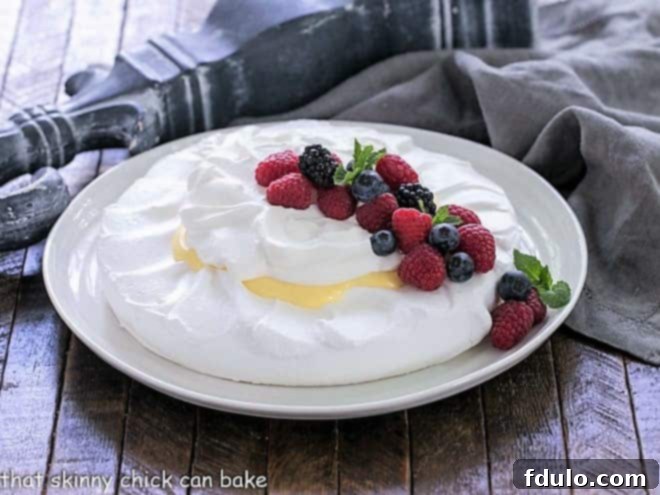Experience a dessert that’s truly a dream: this exquisite Lemon Pavlova. It’s a symphony of textures and flavors, combining a perfectly crisp meringue shell, a velvety smooth lemon curd, a generous cloud of freshly whipped cream, and a vibrant medley of luscious fresh berries. Each bite is an absolute swoon-worthy delight, promising a refreshing burst of citrus sunshine balanced by delicate sweetness. Prepare to fall in love with this unforgettable dessert!
Affectionately known in my family as “Lemon on a Cloud,” this spectacular treat was a specialty of my mom’s and remains one of my most cherished childhood desserts. Its bright, zesty character makes it an absolute triumph for any citrus lover, guaranteeing that everyone at the table will be eagerly clamoring for second, and perhaps even third, servings!
A Visual Feast: The Allure of Lemon Pavlova
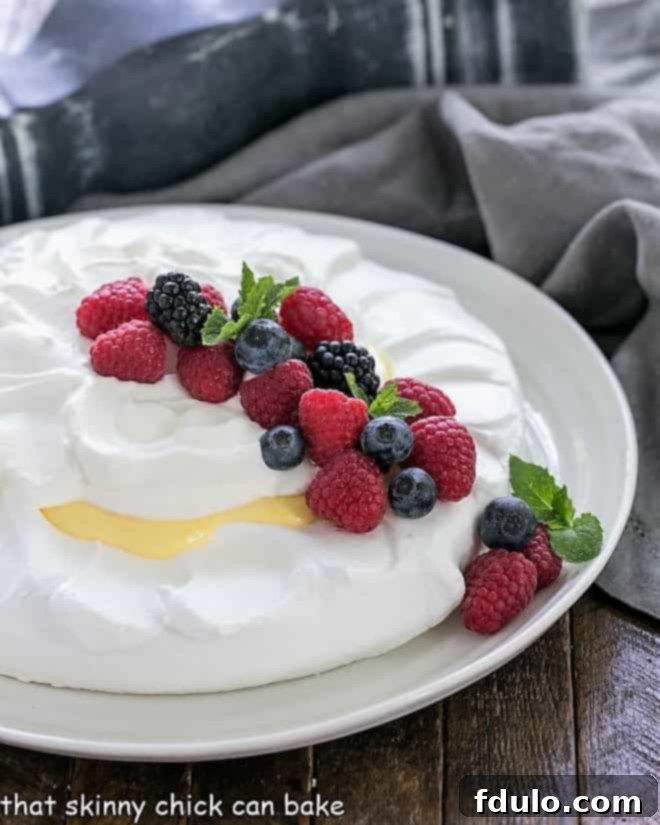
Why This Lemon Pavlova Will Be Your New Favorite Dessert
This Lemon Pavlova isn’t just a dessert; it’s an experience, a masterpiece of culinary simplicity and elegance. Here’s why it deserves a permanent spot in your recipe repertoire:
- A Timeless Family Legacy: This recipe carries with it a beautiful history, originating from my mom’s kitchen back in the 1970s. It’s a testament to its enduring deliciousness that it tastes just as incredible today as it did decades ago. Sharing this recipe feels like passing on a piece of cherished family tradition.
- An Unforgettable Showstopper: Imagine a pristine white meringue shell, baked to airy perfection, cradling a vibrant, sunshine-yellow lemon curd. This is then crowned with billows of fresh, softly whipped cream and adorned with a colorful cascade of mixed fresh berries. Visually, it’s nothing short of spectacular—a guaranteed center piece that will elicit gasps of admiration from your guests.
- Effortlessly Elegant for Any Occasion: Despite its impressive appearance, this lemon pavlova is one of those culinary gems that’s surprisingly straightforward to prepare. It strikes the perfect balance between sophistication and ease, making it an ideal choice for elegant dinner parties, celebratory gatherings, or simply when you want to treat yourself and your loved ones to something truly special. It’s a dessert that feels luxurious without demanding hours in the kitchen.
- A Symphony of Textures and Flavors: The magic of pavlova lies in its contrast. The crisp, melt-in-your-mouth meringue provides a delightful crunch, yielding to a chewy interior. This is perfectly complemented by the silky, tangy lemon curd, the rich, airy whipped cream, and the juicy burst of fresh berries. Every spoonful offers a harmonious blend of sweet, tart, creamy, and crunchy.
Essential Ingredient Notes for a Perfect Pavlova
Crafting the perfect Lemon Pavlova begins with understanding the role of each ingredient. Quality and preparation are key to achieving that ethereal meringue and luscious lemon curd.
- Sugar: A kitchen staple, sugar plays a dual role here. It’s essential for both the structure and sweetness of the meringue, and the balance of the lemon curd. While regular granulated sugar works, superfine sugar (caster sugar) dissolves more readily into the egg whites, leading to a smoother, more stable meringue.
- Egg Whites: These are the backbone of your meringue. For optimal volume and stability, always separate your eggs when they are cold, as the yolks are less likely to break and contaminate the whites. However, for the best whipping results, allow the egg whites to come to room temperature before beating. This allows the proteins to relax and incorporate more air, resulting in a higher, more voluminous meringue. Crucially, ensure not even the tiniest speck of egg yolk is present, and that your mixing bowl and beaters are immaculately clean and completely free from any grease or fat. Any oil residue will prevent the egg whites from whipping properly into stiff peaks.
- Egg Yolks: The rich, creamy foundation of our vibrant lemon curd. The yolks provide both thickening power and a beautiful golden hue, contributing to the luxurious texture of the filling.
- Lemon Juice: The star flavor! For an unparalleled bright, zesty, and authentic lemon taste, freshly squeezed lemon juice is absolutely non-negotiable. Bottled lemon juice, often containing preservatives and lacking the fresh aroma, simply won’t deliver the same vibrant flavor profile that makes this pavlova truly shine. The acidity also plays a vital role in stabilizing the meringue.
- Heavy Whipping Cream (36% Butterfat): This is what creates that heavenly cloud of whipped cream. Opt for heavy whipping cream with a minimum of 36% butterfat content. This higher fat percentage ensures that your cream whips up thick, stable, and holds its shape beautifully, providing a rich, creamy contrast to the crisp meringue and tangy lemon.
- Fresh Berries: While not technically part of the core recipe, a medley of fresh berries (strawberries, raspberries, blueberries, blackberries) is indispensable for garnishing. They add a burst of color, fresh acidity, and another layer of texture that elevates the entire dessert.
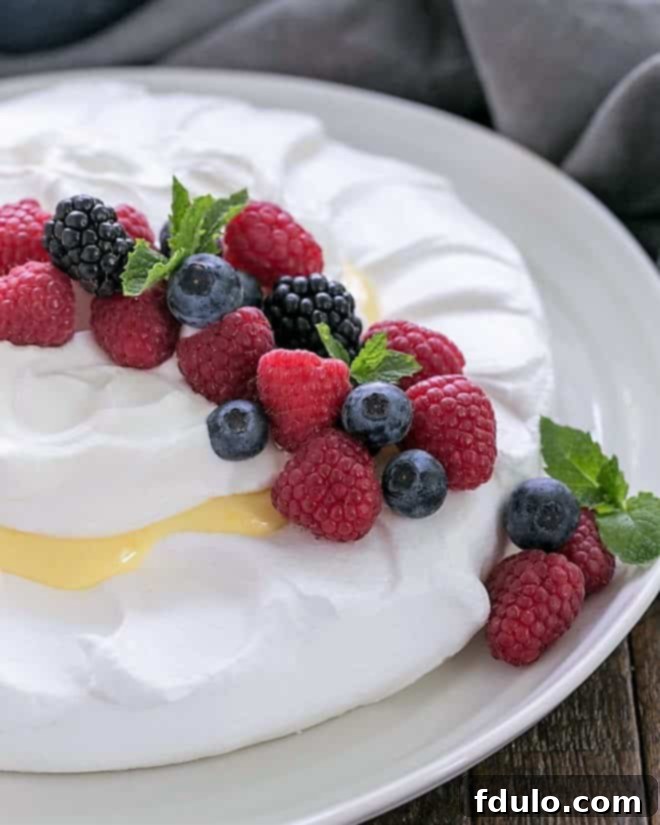
A Taste of Childhood: My Journey to This Lemon Pavlova
My fondest memories of this dessert are deeply intertwined with my childhood home. We had this colossal freezer tucked away in the musty depths of our basement, a veritable treasure trove. It was perfect for storing enormous cuts of beef my parents would occasionally purchase or, more excitingly for us kids, the bounty from their runs to the Sara Lee outlet in Des Moines. They’d return with boxes upon boxes of pastries, including irresistible cheese danishes. But amongst all these frozen delights, one item held a special, almost mythical status: Mom’s “Lemon on a Cloud.”
She would typically prepare a double batch of this lemon meringue dessert, wisely stashing one away in the cavernous freezer for a rainy day. However, my sisters and I possessed a remarkable sixth sense for its existence. As soon as its frosty presence was confirmed, a clandestine operation would begin. We’d sneak down to that cool, damp cellar, armed with a knife, and stealthily carve out slivers of this citrus beauty. I can still vividly recall the sticky sweetness on our fingers and the profound satisfaction of our sweet tooths before we’d tiptoe back upstairs, leaving behind only the faintest evidence of our delicious transgression.
Years later, with those childhood flavors etched into my memory, I embarked on a mission to recreate my mom’s iconic recipe. My initial attempts, while delicious in their own right, diverged slightly from her original. I believe her version featured a more pronounced, vibrant lemon curd topping, often finished with a generous dollop of Cool Whip. My family absolutely adored my rendition, but I confess, I still harbor a nostalgic longing for the precise taste of her handwritten recipe card. The next time I visit Iowa, a treasure hunt for that card in her recipe box is definitely on the agenda! It was through this journey of culinary nostalgia that I first tasted what I later learned was a classic pavlova – a dessert that has since become a cherished staple in my own kitchen. This Lemon Pavlova is my heartfelt tribute to those sweet childhood memories and my mom’s incredible baking.
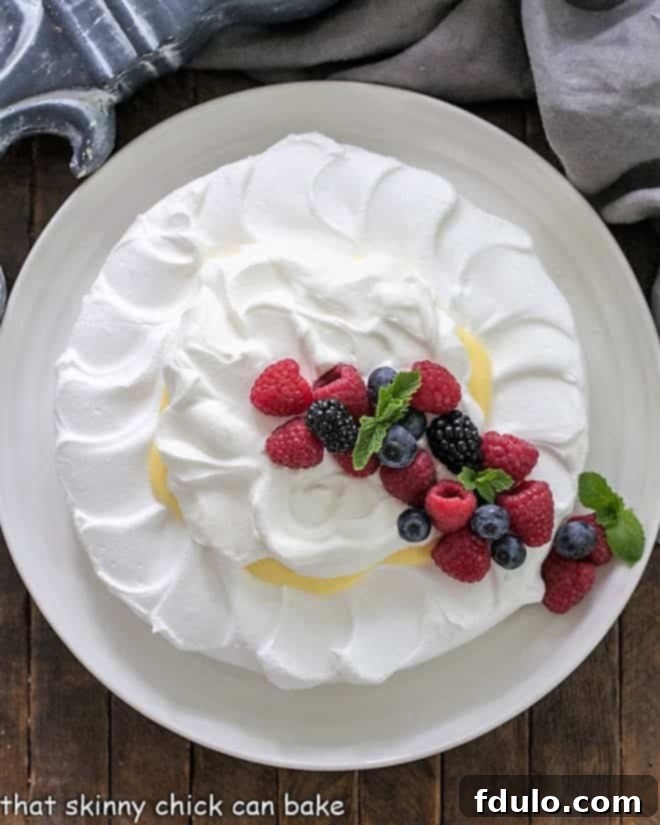
Mastering the Meringue: Expert Tips for Pavlova Perfection
If you’ve ventured into making meringue cookies or a classic pie topping, then tackling a pavlova recipe will feel remarkably familiar and straightforward. Follow these expert tips closely, and you’ll be well on your way to creating a stunning, successful pavlova dessert every single time.
- Immaculate Equipment is Non-Negotiable: This is a crucial first step for meringue success. Before you even think about whipping your egg whites, ensure your mixing bowl (preferably glass or metal) and your beaters are scrupulously clean and absolutely free of any grease or fat residue. Even a microscopic speck of oil can prevent your egg whites from whipping up to their full, billowy potential. A quick wipe with a paper towel dampened with lemon juice or vinegar can help ensure a pristine surface.
- The Goldilocks Principle for Egg Whites: For optimal separation, eggs are best when cold, as the yolks are firmer and less likely to break. However, for maximum volume and a stable meringue, allow your separated egg whites to come to room temperature. Room temperature whites whip up much faster and achieve greater volume, resulting in a lighter, airier meringue. To speed up this process, you can place the bowl of egg whites into a larger bowl of warm (not hot!) water for about 10-15 minutes while you gather your other ingredients.
- Creating Your Meringue Template: To ensure a perfectly shaped pavlova, line your baking sheet with a piece of parchment paper. Using a pencil, trace a circle on one side of the parchment to your desired pavlova size (this recipe suggests a 9-inch circle). Then, flip the parchment paper over so the pencil mark is on the underside. This provides a clear guide for spreading your meringue mixture without getting pencil on your food.
- PRO-Tip: Sizing Your Pavlova: For this Lemon Pavlova recipe, which calls for a 9-inch circle, I often use a 9-inch round cake pan as my template. Simply invert the pan onto the parchment and trace around it. Make sure your marking is dark enough so it’s easily visible through the parchment once flipped.
- Gradual Sugar Addition is Key: Begin beating your egg whites until they become foamy. Then, gradually add the sugar, about one tablespoon at a time, allowing each addition to fully dissolve before adding the next. This slow incorporation is vital for creating a strong, stable meringue. Continue beating until the mixture is very stiff, glossy, and holds firm peaks. If you gently rub a tiny bit of meringue between your fingers, you shouldn’t feel any sugar granules. Superfine sugar (also known as caster sugar) is ideal here as it dissolves faster, but regular granulated sugar works perfectly well with a little more beating time.
- The Magic of Acid: Once all the sugar is combined and your meringue is glossy, add the lemon juice. The acid in the lemon juice (or cream of tartar, which is also commonly used) is a secret weapon. It helps to delay the coagulation of the egg white proteins, making the meringue more flexible and ultimately fluffier and more stable. Fresh eggs are also naturally more acidic, contributing to a lighter meringue.
- Shaping Your Meringue Shell: Mound the whipped meringue mixture into the center of your traced circle on the parchment paper. Using an offset spatula, gently spread and shape the meringue into a flat-topped circle. This recipe specifically calls for creating a “well” or slight indentation in the center of the meringue. This hollow will serve as the perfect cradle for your luscious lemon filling, so try to make it deep enough to accommodate a generous amount.
- Low and Slow Baking: Pavlovas and meringues are typically baked at a low temperature for an extended period. This “low and slow” approach is crucial for drying out the meringue gently, allowing it to become crisp on the outside while remaining slightly chewy in the center, and importantly, preventing it from browning. You want that beautiful, pristine white color.
- Patient Cooling: Once baked, do not rush the cooling process. Turn off the oven, crack the door slightly (you can prop it open with a wooden spoon), and allow the meringue shell to cool completely inside the oven. This slow cooling prevents the meringue from cracking or collapsing due to a sudden change in temperature. Ensure it’s fully cooled to room temperature before attempting to top it with any fillings.
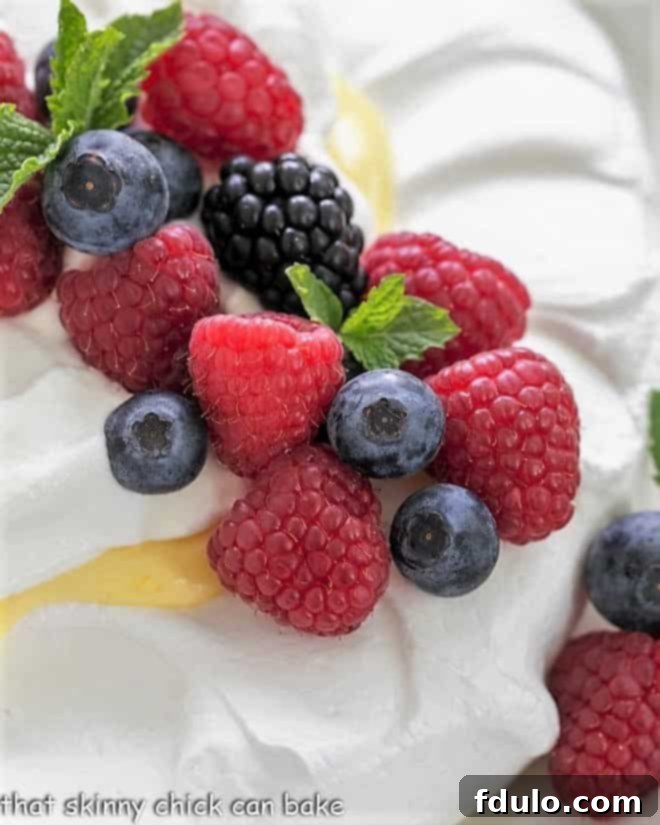
Frequently Asked Questions About Pavlova
What Exactly is a Pavlova?
A Pavlova is an iconic meringue-based dessert, known for its crisp crust, soft and marshmallow-like interior, and elegant presentation. It’s traditionally topped with a generous layer of whipped cream and an abundance of fresh fruit. Its exact origin is a subject of passionate debate between Australia and New Zealand, both countries proudly claiming to have invented this beautiful dessert, which was named in honor of the famous Russian ballerina, Anna Pavlova, during her tours in the 1920s.
How Should I Store a Pavlova?
The meringue shell itself is quite robust and can be stored unfruitfully and uncovered (to maintain crispness) at room temperature in a cool, dry location for up to two days. However, once the pavlova is assembled with the lemon curd, whipped cream, and fresh berries, it becomes more perishable. At this stage, it must be refrigerated to maintain its freshness and food safety.
How Long Will an Assembled Pavlova Keep Fresh?
For the absolute best taste, texture, and visual appeal, an assembled pavlova is truly at its peak when eaten on the day it’s prepared, ideally within a few hours of assembly. Over time, the moisture from the toppings will gradually begin to soften the crisp meringue shell. While it will still be safe to eat for a couple of days after assembly when stored in the refrigerator, the meringue will lose some of its desired crispness, and the fruit topping may not look as fresh. It’s a dessert that encourages prompt enjoyment!
Explore More Luscious Lemon and Dessert Recipes
If this Lemon Pavlova has ignited your love for vibrant citrus desserts and delightful baked goods, you’re in for a treat! Discover more delectable recipes that are sure to satisfy your sweet cravings:
- Lemon Bar Cookie Cups from Barbara Bakes
- Easy Lemon Bundt Cake
- Mile High Lemon Meringue Pie
- Lemon Cake with Lemon Curd
- Creamy Lemon Tart
- Explore more of the Best Dessert Recipes
Stay connected and share your culinary creations with me! Find me on social media @ Instagram, Facebook, and Pinterest. Don’t forget to tag me when you try one of my recipes! If you love the results and enjoyed this Lemon Pavlova, please consider leaving a 5-star rating in the recipe card below. Your feedback means the world to me!

Lemon Pavlova (Lemon on a Cloud) Recipe
45 minutes
2 hours 20 minutes
3 hours 5 minutes
8 servings
A spectacularly crisp meringue shell, generously topped with a silky lemon curd and a cloud of fresh whipped cream, creating a delightful “Lemon on a Cloud” experience.
Based on 4 reviews: 5 stars
Ingredients
- 4 large egg whites, at room temperature
- 1 cup granulated sugar
- 1 teaspoon fresh lemon juice (for meringue)
- 4 large egg yolks
- ½ cup granulated sugar (for lemon curd)
- ¼ cup fresh lemon juice (for lemon curd)
- 1 cup heavy whipping cream
- Optional: Fresh berries and mint for garnish
Instructions
- Prepare Meringue Shell: Preheat your oven to a low 200°F (95°C). Line a baking sheet with parchment paper and trace a 9-inch circle on the underside. In a large, impeccably clean bowl, beat the room-temperature egg whites with an electric mixer until they become foamy.
- Gradually add 1 cup of sugar, one tablespoon at a time, continuing to beat until the mixture is very stiff, glossy, and holds firm peaks. Make sure the sugar is fully dissolved.
- Gently fold in 1 teaspoon of lemon juice until just combined.
- Pile the meringue mixture into the center of the traced circle on the parchment paper. Spread it out to the edges, building up the perimeter slightly to create a shell-like structure with a well in the center for the filling. Alternatively, you can bake the meringue in a lightly greased 9-inch pie plate.
- Bake the meringue for 2 hours. Once baked, turn off the oven, crack the door open slightly, and allow the meringue to cool completely inside the oven to prevent cracking. This will take at least another hour, possibly more.
- Prepare Lemon Curd: While the meringue bakes and cools, combine the egg yolks, ½ cup of sugar, and ¼ cup of lemon juice in a small saucepan. Cook over low heat, whisking constantly, until the mixture thickens to a pudding-like consistency. Do not boil. Remove from heat and transfer to a clean bowl. Cool the lemon curd at room temperature, then refrigerate until thoroughly chilled.
- Assemble the Pavlova: In a separate clean bowl, beat the 1 cup of heavy whipping cream until stiff peaks form.
- Using the same beaters (no need to wash if used only for cream), briefly beat the chilled lemon curd until it is smooth. Gently fold about ½ cup of the whipped cream into the lemon curd until just blended.
- Carefully spoon and pile the lemon filling into the cooled meringue shell.
- Chill and Serve: Reserve the remaining whipped cream in the refrigerator. Cover the assembled pavlova loosely and chill it for at least 2 hours before serving. Just before serving, top the pavlova with the reserved whipped cream and garnish generously with fresh berries and mint, if desired.
Notes
- Ensure there is absolutely no egg yolk in your egg whites, or they will not whip properly.
- Superfine (caster) sugar dissolves more easily, leading to a smoother meringue, but regular granulated sugar works fine with sufficient beating.
- Your mixing bowl and beaters must be completely free of oil or grease for the egg whites to whip well.
- The total time, including significant cooling periods for both meringue and lemon curd, is closer to 5 ½ hours. Plan accordingly!
Recommended Products
As an Amazon Associate and member of other affiliate programs, I earn from qualifying purchases.
- USA Pan Bakeware Half Sheet Pan
- KitchenAid 9-Speed Digital Hand Mixer
- Superfine Sugar
Nutrition Information:
Yield:
8
Serving Size:
1
Amount Per Serving:
Calories: 284
Total Fat: 13g
Saturated Fat: 8g
Trans Fat: 0g
Unsaturated Fat: 5g
Cholesterol: 126mg
Sodium: 42mg
Carbohydrates: 39g
Fiber: 0g
Sugar: 39g
Protein: 4g
